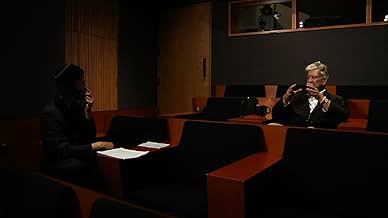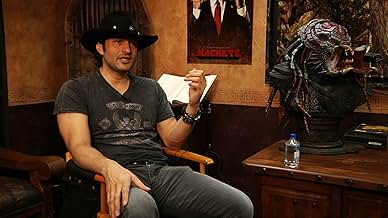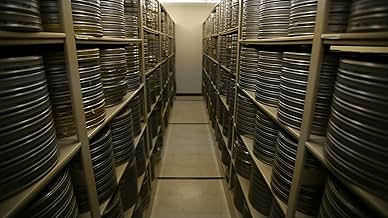NOTE IMDb
7,6/10
14 k
MA NOTE
Ajouter une intrigue dans votre langueThe documentary investigates the history, process and workflow of both digital and photochemical film creation.The documentary investigates the history, process and workflow of both digital and photochemical film creation.The documentary investigates the history, process and workflow of both digital and photochemical film creation.
- Réalisation
- Scénario
- Casting principal
- Récompenses
- 1 nomination au total
Avis à la une
One of the most important things about a documentary is subject matter. If you do not have an interesting topic then you will not only get the viewers but you won't be able to keep them. The latest documentary film Side By Side does something a little bit different than most of this genre. It tackles a subject that those outside the industry may know nothing about but are affected by it nonetheless.
Side By Side takes a tour through the history of filmmaking through the impact that the rise of digital filmmaking has had. Featuring an impressive list of filmmakers including George Lucas, Martin Scorsese, James Cameron, Robert Rodriguez, David Lynch, David Fincher, Steven Soderbergh, Christopher Nolan as well as numerous industry professionals this film explores both the good and bad of this rise of the digital age through the creative eyes of those that make these films. For anyone that loves film this is a must see documentary. Not only do you see how it affected tons of different movies, but also how it changed the industry. With Keanu Reeves leading the charge interviewing the power house of Hollywood it delivers a different side of the world of imagination that we all love. In addition to getting a peek behind the curtain that audiences normally never think twice about, we are also given a look at who really had their hand in this evolutionary change and what films took these leaps. This is an effective film that works on many levels more than just a documentary on cameras. It tells the story of film processing, camera evolution, filmmaking, and a true chance for those that work behind the scenes to give their opinions and thoughts on this evolution, the good and bad.
There are some very emotional responses here that really show the love these filmmakers have for what they do and will offer a great inside look and should give you a new respect for the process and creators as well as the films themselves. Some feel this is the end of true film while others feel this is the birth of unlimited creativity, either way this film evokes an emotional response both on the screen and from the viewer which is what film is all about.
http://www.examiner.com/movie-in-dallas/bobby-blakey
Side By Side takes a tour through the history of filmmaking through the impact that the rise of digital filmmaking has had. Featuring an impressive list of filmmakers including George Lucas, Martin Scorsese, James Cameron, Robert Rodriguez, David Lynch, David Fincher, Steven Soderbergh, Christopher Nolan as well as numerous industry professionals this film explores both the good and bad of this rise of the digital age through the creative eyes of those that make these films. For anyone that loves film this is a must see documentary. Not only do you see how it affected tons of different movies, but also how it changed the industry. With Keanu Reeves leading the charge interviewing the power house of Hollywood it delivers a different side of the world of imagination that we all love. In addition to getting a peek behind the curtain that audiences normally never think twice about, we are also given a look at who really had their hand in this evolutionary change and what films took these leaps. This is an effective film that works on many levels more than just a documentary on cameras. It tells the story of film processing, camera evolution, filmmaking, and a true chance for those that work behind the scenes to give their opinions and thoughts on this evolution, the good and bad.
There are some very emotional responses here that really show the love these filmmakers have for what they do and will offer a great inside look and should give you a new respect for the process and creators as well as the films themselves. Some feel this is the end of true film while others feel this is the birth of unlimited creativity, either way this film evokes an emotional response both on the screen and from the viewer which is what film is all about.
http://www.examiner.com/movie-in-dallas/bobby-blakey
As a film student or just a movie lovers, you rarely got a chance to connect with cinema history, or meet with famous people in the industry who set the standard and created the masterpieces. This documentary gives it all in a friendly story telling mode that could benefit both professionals or just any random viewers
As much as it is about digital, it's equally about how cinema develop and what it would be like in the future. The documentary points out an interesting finding that it's the professionals, not the technology that drives the storytelling art forward. Each and every of them offer their best performance and artistry via the choice of techniques they made.
It's fantastic to see how filmmakers form different groups of opinions and stay faithful to it. While the film did not intend to come to any conclusion about future of cinema in digital or old style film, it clearly set up a basic understanding about filmmaking as a painstakingly process that require endless decision making based on personal visual creative interpretation.
A nice to watch movie for film students, especially those are fans of David Lynch, James Cameroon or George Lucas, the main speakers
As much as it is about digital, it's equally about how cinema develop and what it would be like in the future. The documentary points out an interesting finding that it's the professionals, not the technology that drives the storytelling art forward. Each and every of them offer their best performance and artistry via the choice of techniques they made.
It's fantastic to see how filmmakers form different groups of opinions and stay faithful to it. While the film did not intend to come to any conclusion about future of cinema in digital or old style film, it clearly set up a basic understanding about filmmaking as a painstakingly process that require endless decision making based on personal visual creative interpretation.
A nice to watch movie for film students, especially those are fans of David Lynch, James Cameroon or George Lucas, the main speakers
I tend to read proper film critics for their opinions not only on specific films but also essays on themes, genres, movements and so on; I consider myself a total amateur on such subjects but I find it interested to listen to those who are not. Coming to Side by Side I wasn't sure if it would be too dry for me to get into or if it would be too simplistic for me to stay interested in for just under two hours. The film essentially looks at the transition from celluloid to digital in film making – from filming through to post through to projection in the cinema and the means of delivery to the viewer. It is an ambitious goal but it is one that it does very well and in a way that flows and is accessible.
I guess that for those with a real good working knowledge of the technology and the process, it may be too simplistic but for the casual viewer and enjoyer of films, there is enough detail here to engage and interest, but not so much that I felt overwhelmed with technical detail that I wasn't interested in. The film is really made up of Reeves acting as interviewer with a range of people involved in all the various aspects of the process – directors, cinematographers, editors, camera manufacturers etc. and he does a decent job, but not a great job in this regard. Fortunately this is not really his main role because it certainly seems that as producer he has helped Kenneally get a lot of very famous people to agree to be in the film. This range of talent and opinion makes for an interesting film, so while we follow development of things over time, we tend to get both sides as the title suggests.
Most of the contributors are interesting and their soundbites are well edited and the film itself is put together very well so that it covers time and technology in a way that makes sense, engages and never outstays its welcome. It probably won't do much for the technical enthusiast but for fans of film and cinema it is very much worth seeing as entertainment and education.
I guess that for those with a real good working knowledge of the technology and the process, it may be too simplistic but for the casual viewer and enjoyer of films, there is enough detail here to engage and interest, but not so much that I felt overwhelmed with technical detail that I wasn't interested in. The film is really made up of Reeves acting as interviewer with a range of people involved in all the various aspects of the process – directors, cinematographers, editors, camera manufacturers etc. and he does a decent job, but not a great job in this regard. Fortunately this is not really his main role because it certainly seems that as producer he has helped Kenneally get a lot of very famous people to agree to be in the film. This range of talent and opinion makes for an interesting film, so while we follow development of things over time, we tend to get both sides as the title suggests.
Most of the contributors are interesting and their soundbites are well edited and the film itself is put together very well so that it covers time and technology in a way that makes sense, engages and never outstays its welcome. It probably won't do much for the technical enthusiast but for fans of film and cinema it is very much worth seeing as entertainment and education.
This is a documentary that every film enthusiast must watch. It will give you an understanding of the ways a feature film is shot and projected. To the unaware today most movies are shot on digital cameras as opposed to the photochemically styled film cameras of the past days. Both have their plus and minuses and in this documentary, Keanu Reeves goes about explaining the differences of the format and the opinion of most famous filmmakers on the subject. Featuring everyone from James Cameron to Martin Scorsese Side by Side is a great look at the technical aspect of cinema.
Hollywood insiders are aware of a battle that has been brewing for quite sometime now: the technology to capture the image has two camps- film and digital and each are perhaps overwhelming the other. Film is photomchemical and the method by which cinema has been created and projected for all these years (since the late 1890). Digital cameras are new on the block and because they can do everything a film camera can but with less production costs, they are vying to be the medium every director chooses. Keanu Reeves questions industry insiders from top directors and cinematographers and gets a honest non biased overview. This is a good watch for anyone interested in the technical and "behind the camera" scenes of making of film and television. The documentary is precise and educative.
Le saviez-vous
- GaffesIdentifies District 9 (2009) as being shot on the Sony F23. It was actually shot on Red One cameras.
- Citations
Martin Scorsese: The only way you can make sure that a film or anything on the moving image is going to be around sixty or seventy years from now, interestingly enough, ironically enough, is celluloid.
- ConnexionsFeatured in Film '72: Épisode datant du 13 février 2013 (2013)
Meilleurs choix
Connectez-vous pour évaluer et suivre la liste de favoris afin de recevoir des recommandations personnalisées
- How long is Side by Side?Alimenté par Alexa
Détails
Box-office
- Montant brut aux États-Unis et au Canada
- 58 825 $US
- Week-end de sortie aux États-Unis et au Canada
- 6 956 $US
- 19 août 2012
- Montant brut mondial
- 67 054 $US
- Durée
- 1h 39min(99 min)
- Couleur
- Rapport de forme
- 1.85 : 1
Contribuer à cette page
Suggérer une modification ou ajouter du contenu manquant





































